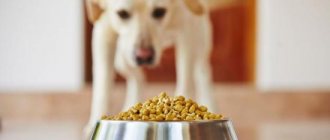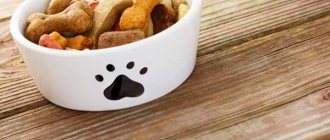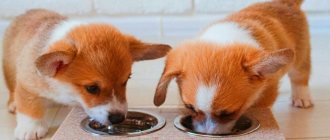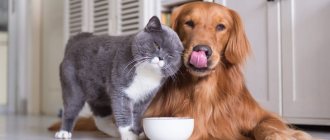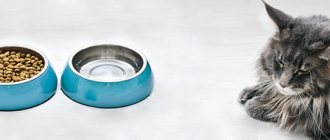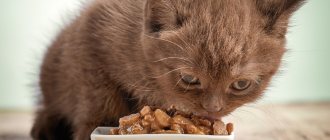Advantages and disadvantages of dry food
Dry food is finely ground, evenly mixed food, prepared in the form of aromatic dry croquettes, which can have different shapes and sizes. Such products include meat, offal, grains, vegetable oils, and animal fats. The food is enriched with vitamins, minerals, amino acids, and valuable natural additives.
Benefits of dry dog food:
- Wide variety of tastes.
- Long shelf life.
- Save time.
- There is no need to calculate the daily food requirement, since responsible manufacturers always indicate the average dosage of food, taking into account the age and weight of the dog.
- Dry food can be taken on a trip or trip. Fragrant granules are an ideal treat, which are often used as a reward for obedience on walks or during training at training grounds.
- High-quality feed has a completely balanced composition in terms of the percentage of amino acids, proteins, fats, carbohydrates, minerals and vitamins.
- If necessary, you can adjust the diet, select therapeutic, dietary, therapeutic and prophylactic food.
- Dry food cleans teeth from plaque and improves the condition of gums.
Important! Veterinarians often prescribe dry industrial food for dogs during the recovery period, weakened animals, pets with systemic pathologies, and gastrointestinal diseases.
One of the disadvantages of dry food is the high cost of keeping a dog, since high-quality products have a fairly high price.
One of the disadvantages is that dogs often get used to such a diet, so if necessary, switching to natural feeding may take some time.
Dry puppy food GO NATURAL Sensitivity + Shine Dog Recipe
GO NATURAL Sensitivity + Shine Dog Recipe is a grain-free food designed for adult dogs and puppies with sensitive digestive systems. The basis of the product is turkey meat. This food is rich in high-quality proteins and Omega-3 and Omega-6 fatty acids.
The product contains lentils as a source of carbohydrates. Sensitivity + Shine Dog Recipe is approved for dogs sensitive to potato starch and those on a grain-free diet.
The food contains no ingredients such as by-products, GMOs, artificial preservatives, gluten, beef, wheat, corn and soy.
Owner reviews of Sensitivity + Shine Dog Recipe are positive. Dogs eat this brand of food with pleasure. No allergies or digestive problems have been identified. The granules are medium in size and hard, but puppies can easily chew them. Digestion and stool are normal, no gas. The coat is shiny.
You can buy these products in many online stores by entering the query “buy dry food for puppies” into a search engine.
- Country of origin: Canada.
- Manufacturer: PETCUREAN Pet Nutrition.
- The size of the dog is any, as is the age: suitable for both adults and puppies.
- Price – from 233 rubles for 230 g to 4,464 rubles for 11.35 kg.
- Appearance of the puppy – 5.
- Impact on health – 5.
- Feed quality – 5.
- Smell – 5.
- Packing – 4.
Summary : the food is excellent, especially for allergy sufferers and for puppies with stomach problems. The problem with storing an open pack is that you need an airtight container.
Rules for selecting food
If you decide to keep your dog on ready-made diets, you must not only take into account the advantages and disadvantages of dry food, but also know the basic criteria and rules for selecting food for your pet:
- When choosing food, take into account the breed, individual, physiological characteristics (weight, dimensions), taste preferences of the pet, activity, level of physical activity, hair length. Pay attention to the animal's need for minerals, vitamins, and nutritional components.
- The food must be appropriate for the dog's age . Puppy food is not suitable for adult dogs and vice versa. Dogs of different age groups have different needs for certain beneficial substances.
- Products must have a completely balanced composition in terms of protein, fat, and carbohydrate content.
- To feed dogs, use products of the highest category and class.
- Consider the climatic features of the region and the time of year. For animals living in northern climate zones, food should be more nutritious and high in calories.
- Dry food is not suitable for feeding puppies up to 2-2.5 months , for old, elderly dogs, weakened individuals. Do not feed dry food when switching from natural to ready-made food.
- Follow the dosage portions. The daily requirement is indicated by the manufacturer on the packaging. At the same time, take into account the activity, stress, and other characteristics of your dog’s body. The dog should not overeat or undereat.
- Feed your dog products of the same brand and brand. If you need to change ready-made food, do it gradually.
- Buy products from well-known brands and brands. Do not feed your pet low-grade dry food or food consisting of bright, multi-colored granules.
When choosing dry food, you need to take into account the health of your pet. For dogs with problematic digestive tracts and weakened animals, the brands’ lines include special therapeutic and preventive dietary foods.
Feed quality
The best dry food for puppies is premium, or better yet, super premium products. You should not trust actively advertised brands. It is not recommended to purchase food sold by weight: it is difficult to monitor their quality, and the granules quickly oxidize, losing nutritional value and changing taste characteristics. It is worth choosing dry food for puppies taking into account the composition and price. High-quality products are never cheap.
Important : a large amount of animal protein indicates that this food is high-quality. If the ingredient list starts with grains, such as corn, then it is an economy-class product. This component provides good volume and makes the dog feel full, but its nutritional value is low, as is its digestibility.
The quality of the food determines how much dry food your puppy needs. High-quality mixtures are better absorbed by the body and digested well, their energy value is higher. For these reasons, the daily intake of premium food will be lower, but the benefits from it will be greater, including due to the saturation of nutrients. This class is distinguished by the obligatory presence of fatty acids, glucosamine, probiotics, and chondroitin. High-quality products are distinguished by a high content of natural antioxidants, vitamins, and herbs. The more of these components, the better the mixture.
The presence of ingredients such as odor simulators, food colorings or artificial preservatives in the list indicates a low-quality product. Such compounds can disrupt the normal functioning of the liver and kidneys, cause anemia, skin reactions, food allergies, and so on.
By-products are added to both elite feed and economy-class feed. This could be the heart or liver of a bird, as well as cattle. Offal such as trimmings, intestines, feathers or lungs are added exclusively to economy class products.
Only dry food or mixed feeding: which is correct?
Many owners often ask the question on thematic forums: “Only dry food or mixed feeding: how to feed the dog correctly?”
And so, a mixed (combined) diet involves feeding pets with industrial food and natural products, or a combination of food with different structure.
In the first case, this feeding option (natural food + ready-made food), according to many veterinarians, does not bring much benefit and can cause metabolic disorders and systemic disorders in the body due to the fact that each type of food is absorbed and digested over different periods of time.
Important! If you want to treat your pet with a natural treat, give them about 6-7 hours after the main meal.
The mixed feeding option is suitable only for clinically healthy animals. Combined feeding is suitable for puppies and young dogs, but can harm older pets, individuals prone to food allergies, and those with gastrointestinal problems.
Let us note that natural products with a ready-made diet can be fed to working dogs, service dogs, and individuals with increased physical and mental stress. This type of nutrition is justified for pregnant and lactating bitches. Ready-made food can be supplemented with fruits, vegetables, berries, herbs, fermented milk products, eggs, fish, and offal.
Combination nutrition can be used if there is a need to switch the dog to a different diet, for example, from natural food to ready-made food or vice versa.
However, if you keep your pet on a ready-made diet, you should not give exclusively dry food. Combine dry granules with wet, semi-moist, canned food, pates, mousses, purees. For example, at one feeding the dog receives dried food, at another - canned food, pate, wet pieces in sauce, jelly. For feeding, choose dry and wet food of the same brand.
How to feed puppies correctly: about the daily routine
In order for the puppy to eat well and digest food well, it must be fed every day at the same time. At 1.5–2 months he will need 5–6 feedings, then the number is gradually reduced, bringing it to three by 6 months. By the end of the first year of life, most dogs are ready to switch to two meals a day.
It is unacceptable to keep food freely available around the clock. If the puppy did not touch the food or did not finish it, you should not admonish him like a capricious child. Calmly remove the bowl and return it only when it is time for the next feeding.
Sometimes dog breeders argue about how to properly feed a puppy dry food before or after a walk. It is difficult to give a definite answer here: it all depends on the situation and the age of the pet. If you are just toilet training your puppy, it is wise to take him outside half an hour after feeding: most likely, it is at this time that he will want to relieve himself. But such a walk should not be long or too active.
Grown-up puppies with already formed neatness skills are walked strictly until they eat. This not only helps the pet to work up an appetite, but also serves as a prevention of gastric volvulus - a dangerous condition that requires urgent surgery.
Classes of dry dog food
The quality of finished industrial feeds and their cost depend on the category or class.
Dry food classes:
- Economy
- Premium
- Super premium.
- Elite.
- Holistic.
High category food has a completely balanced composition, which contains everything necessary for the health and development of your pet. Remember that you can feed your dog only high-quality, high-class food.
Economy class
Economy class food is not suitable for feeding dogs, despite its attractive price and advertising. They should not be used even as a top dressing or treat, since such products are made from low-grade raw materials (technical deboned meat, offal, grain crops, soybeans, fish, meat and bone meal).
Economy feed contains dyes, stabilizers, preservatives, flavorings, and other ingredients that are harmful to animals. They are low in vitamins, amino acids, and minerals, which can cause hypovitaminosis in dogs.
Important! Economy category products have low nutritional and energy value.
Economy class feed:
- Darling.
- Caesar.
- Chappi.
- Kennel yard.
- Oscar.
- Meal.
- Our brand.
- Pedigree.
- Friskies.
Long-term feeding of cheap economy food can, over time, cause the development of serious problems and diseases of the digestive tract. Economy feed often causes food allergies and disrupts metabolism.
Premium class
Premium class feeds are popular with many breeders. Unlike economy category products, such feeds have a more balanced composition and high nutritional value. Made from natural ingredients (25-35%), but may include grains. Practically do not contain dyes or flavor enhancers. The composition is enriched with vitamins, amino acids, minerals, herbs, and vegetables.
Premium food:
- Royal Canin.
- Hill's.
- Pro Plan.
- Purina ONE.
- Brit Premium.
- Advance.
- Nature's Protection.
Premium food is a good option for a dog’s daily diet, but veterinarians and breeders still recommend giving preference to super-premium category food for daily feeding of pets.
Super premium
Super premium dry food has a 100% balanced composition. Consist of high-quality natural ingredients (calf, lamb, poultry, rabbit). Contains grains in minimal quantities. Enriched with vegetables, herbs, and all necessary nutrients.
Important! If a puppy receives high-quality professional food, he quickly grows, develops, gains muscle mass and the necessary condition.
Super premium food:
- 1st Choice.
- Nutram.
- Eukanuba.
- Trainer.
- Monge.
- Dukes Farm.
- Brit Care.
- Gina.
- Porcelan.
- Bosch.
- Optima Nova.
- DailyDog.
The composition of premium category products of various brands differs little in the content of main ingredients and vitamins. Therefore, when choosing a diet, take into account your pet’s taste preferences, his age, weight, and activity.
Holistic
Holistic food is the best you can offer your pet. Holistic products are made exclusively from natural ingredients. Contains probiotics, enzymes, vitamins, amino acids, minerals, herbs, vegetables, berries, as well as substances that improve metabolism and digestion.
This category of feed does not contain any harmful substances, chemical compounds, by-products, or soy. All components of the food are perfectly balanced.
Holistics for dogs:
- Acana.
- Savarra.
- Now Fresh.
- Orijen.
- Canidae
- Grandorf.
- Go Natural holistic.
- Summit.
- Holistic Blend.
- Farmina N&D.
- Pronature Holistic.
Holistic dry food is complete and provides the animal’s body with all the necessary substances. Ideal for puppies, weakened pets, individuals with a sensitive digestive tract, dogs who are often diagnosed with nutritional allergies.
Is it possible to feed a dog exclusively dry food?
Not only is it possible, but it is necessary! When developing the composition for future dry food, manufacturers expect that the dog will eat this product constantly. But many owners do this - they feed the dog regular food, and give food only as a treat or reward. This is fundamentally wrong. If you are going to feed your pet dry food, everything else should be removed from his diet.
If you feed your dog food and supplement it with meat, there may be an excess of protein in the body, which leads to various problems in the functioning of the kidneys. If you give your dog dry food and supplement it with fish, this leads to an excess of phosphorus. If there is a lot of phosphorus in the body, the dog will suffer from urolithiasis, the bones will become loose and brittle, and anemia will appear. When feeding porridge, there will be an excess of carbohydrates, which leads to excess weight and related problems.
In addition, with a mixed diet, a dog’s stomach has to constantly adapt to either dry food or regular human food. Frequent changes can lead to gastritis.
The exception to the rule is small pieces of treats that can be used as rewards during training. You can pamper your dog with pieces of cheese, dried fruits, crackers or boiled meat.
All these arguments suggest that you can feed your dog only dry food, and it will not need additional nutrition. But how much food does a dog need to keep him from overeating and feeling good?
how to remove fleas from a dog at home
Feeding standards
The daily requirement depends on the age, weight, breed, and size of your dog.
Manufacturers indicate on the packaging the average daily dosage, taking into account the weight and age of the dogs. Remember that the standards stated on the packaging are just a guideline, since the individual physiological characteristics and needs of a particular individual are not taken into account.
Serving Size
The serving size is selected individually for a particular animal and primarily depends on the age, breed of the dog, as well as on the energy value and calorie content of the food.
Economy feed has 260-320 Kcal, premium – 320-365, super-premium – 360-450 Kcal, holistic – 370-430 Kcal. Therefore, the serving size when feeding premium, economy products will be larger than when feeding a dog with premium food.
Puppies' portions are smaller than those of young, adult animals. At the same time, the daily food intake for puppies up to 6-7 months exceeds the norm for adult dogs by approximately one and a half times.
The daily dosage of food for dogs of large, giant breeds is higher than for representatives of small, decorative breeds.
Divide the recommended daily intake, which is stated on the packaging, into equal parts in accordance with the number of feedings. Do not use a double dosage for feeding, since puppies, especially large, giant breeds, do not always know the measures and often transmit, which ultimately ends in vomiting and other disturbances in the functioning of the gastrointestinal tract.
Dry food is concentrated, so satiety occurs a little later than the dog eats its portion. Even if the dog begs for more or treats after eating, do not follow his lead.
Important! Determining the amount of feed “by eye” is unacceptable. Use kitchen scales and measuring containers. After eating, the dog's bowl was empty.
Exceeding the dosage by 20-25% of the recommended is permissible only for working dogs, sports dogs, lactating and pregnant bitches. A reduction in the daily dosage is possible in case of obesity, excess weight, or according to the indications of a veterinarian.
Feeding frequency
The frequency of feeding depends on the age of the pet. Puppies are fed in small portions (4-6 times a day), but often at regular intervals. Adult dogs are given food once or twice a day.
Train your dog to a certain routine. Give food at the same time. Compliance with the regime and daily routine is the key to excellent health and well-being of your pet.
Regularity rule
Another key point when feeding pets is routine. It is recommended to feed a healthy adult dog twice a day at the same times, for example at 8.00 and 20.00. In this case, the daily dose of dry food is divided into two equal parts. It is undesirable to give the entire daily dose at one time: this increases the risk of complications such as gastric volvulus.
Physical activity immediately after eating is also associated with this dangerous pathology. Therefore, you need to feed your dog strictly after a walk, and not before.
Do not keep dry food freely available between meals. If your pet does not finish its portion or refuses to eat at all, simply put the bowl out of reach. The next feeding should be on schedule and in the usual volume. This will avoid overfeeding and whims on the part of the animal.
Water consumption rate
The rate of water consumption does not depend on the dog’s diet. Water should always be available in unlimited quantities. The bowl should always be full. On average, a dog should drink 50 g of water per kilogram of weight per day.
The amount of liquid consumed by a pet depends on the diet, season of the year, activity, health, and age. Unlike canned food, dried pates contain no water at all, so the dog may feel thirsty after eating.
Use filtered, settled, clean drinking water for your dog. Change the water two or three times every day.
Features of feeding puppies
Have you got a puppy and are you planning to keep him on a ready-made diet? In addition to choosing high-quality food, you need to know the features of dry feeding puppies.
Puppies can be given their first complementary foods starting from 3-4 weeks. Use specially developed mixtures, mousses, pates for puppies. The dog will be able to eat hard granules no earlier than 2.5-3 months.
Puppies can be accustomed to drying from the moment their baby teeth appear. At first, soak the granules in warm water, kefir, milk, and whey. Food should have a pasty, porridge-like consistency.
As the puppies grow, the consistency and density of the food changes. The transition should be gradual. Monitor the condition of your pet, its well-being, and the consistency of its stool.
When picking up a puppy from a breeder, be sure to ask what they used for complementary foods. Feed the dog the same food and products for the first two weeks. A sudden change in diet is stressful for a dog’s body. If the puppy received natural products, the transition to a ready-made diet will take 9-14 days.
Small breed dogs require approximately 300-400 g of food per day. The volume is divided by the number of feedings. For puppies and young dogs of medium breeds - 450-620 g, for puppies of large, giant breeds - 750-910 g.
Features of large and small breeds
When feeding dry food, owners should know the characteristics of large and small breeds. Manufacturers in their lines have products for small, medium, large, and giant dogs. There are also ready-made diets designed to feed dogs of certain breeds.
Small breeds and small dogs are active and energetic even in adulthood. Unlike large breeds, they have a faster metabolism, so the daily diet may be slightly larger in relation to body weight than large dogs.
Do not forget that small dogs are prone to allergies and obesity, so do not exceed the daily dosage specified by the food manufacturer. For feeding, choose holistic, super-premium food, food marked “Mini”.
Small dogs can be easily accustomed to a certain type of dry food, but remember that representatives of decorative breeds are quite picky eaters. Therefore, choose the optimal ready-made diet, taking into account the taste preferences of your four-legged friend.
To feed large active, working, service dogs, choose food marked “Active”, “Energy”, “Premium”, “Superpremium” or any other good food for large breeds. Foods for large dogs have high nutritional value, but lower calorie content. Must contain vitamins, minerals, amino acids, biologically active substances.
Important! The calorie content of the diet depends not only on size, weight, breed, but also on the level of physical and mental stress. Working, hunting, service, and hyperactive dogs should receive a more nutritious, high-calorie diet.
Regardless of size or breed, the finished diet should be nutritious, fortified, and balanced.
The importance of water
Water in food is a key point for proper feeding of a dog. Those who have switched their four-legged friend to homemade products should not worry. Even meat contains about 80% water. But in dry food this figure, as a rule, is no more than 10%. That is why, if you do not want to prepare wet mash, it is imperative to replenish a separate container with clean water. Otherwise, the dog simply will not receive all the vitamins and nutritional components.
Recommended Posts
Standard height and weight of the Cane Corso breed by month
Weight of a puppy and an adult Labrador by month
Weight and height of a German Shepherd puppy by month
Description and content of the hunting border terrier
Description and care of the highly intelligent Border Collie breed
Description of forms and features of treatment of enteritis in cats
How to properly soak dry food
Dry food is soaked for puppies up to 3 months of age, when switching from natural food to a ready-made diet, during the period of changing baby teeth. Also soak the dryer before feeding older pets or if the dog has problems with teeth, gums, or inflammation of the oral mucosa. Let's look at how to properly soak dry food.
Dry granules are soaked in warm drinking water (50-60 degrees) in a ratio of 1/2 or 1/3. The higher the water temperature, the faster the dryer will soak. You can also use milk, kefir, whey.
If the pet refuses to eat the dry food offered, the dry food can be soaked in low-fat fish or meat broth for the first time.
Important! The dosage does not change, even if you soak dry food.
Make sure that the dryer, soaked in water, kefir, or milk, is eaten by the dog within 2-3 hours, as the food becomes chapped, sour, and contaminated with harmful bacteria.
If the dog lives on the street
If a dog lives outside or is kept in an enclosure, its diet should contain more fats, proteins and vitamins to support the immune system. In general, the nutrition of dogs that live on the street differs little from dogs living in a house or apartment. Minor adjustments to the prepared diet are carried out in different seasons of the year. Feeding animals in summer differs from feeding them in winter.
Feeding in summer
In summer, especially during hot periods, dogs may experience a slight decrease in appetite. If your pet constantly leaves food in the bowl, it is permissible to slightly reduce the daily amount, by about 10-15%.
In the summer months, dogs need more wet, semi-moist, canned food, since they contain more moisture than dry food and dogs eat such products more willingly. In this case, the dog must always have access to water.
Feeding in winter
Feeding dogs in winter means a more nutritious, high-calorie diet. Particular attention to nutrition in winter should be paid to individuals who are involved in work, are exposed to physical stress, take part in competitions, or are kept in enclosures all year round.
For feeding, use food marked “Active”, “Energy”, “Super-premium”, holistic.
The prepared diet can be supplemented with vegetable fats, vegetables, high-quality offal, and fermented milk products, if there are no contraindications.
Types of feed
Just like food for humans can be of high quality or not, dog food is also divided into classes.
- Economy class.
Such food is not very high in calories and requires a larger volume so that the dog receives enough nutrition. Economy class food is made from low quality products, essentially waste. If you give your dog such food, take care of additional vitamin and mineral complexes, since economy-class food does not meet the dog’s daily nutritional needs. - Premium class.
The calorie content of such a product is 300-350 calories per 100 grams of product. This food is made from offal, contains a sufficient amount of minerals and vitamins, and does not require additional enrichment. - Super premium.
This is a high quality product that contains all the vitamins necessary for a dog’s body. This is a balanced diet that can become a complete diet for constant feeding. - Holistic class.
This dog food is made from high-quality products and has high nutritional value. Designed for show dogs, pets that are in the rehabilitation period after illness, as well as for pregnant and lactating bitches.
If you only want to feed your dog dry food, choose at least a premium brand. Otherwise, the dog may develop health problems over time.
Separately, I would like to say about fresh food, which is also available for sale. Most manufacturers have in their product line wet food in the form of canned food with pieces of natural meat. It can be given to your dog as an additional source of protein, in the form of a treat. Contrary to popular belief, wet food is not a replacement for dry food and does not contain the full range of beneficial ingredients. However, this food is great for older dogs with bad teeth or gastrointestinal problems.
Dry dog food is a real breakthrough in veterinary medicine. The presence of dry food makes life much easier for both the dog and its owner. If you constantly feed your dog dry food, it gets sick less, its teeth remain strong for many years, and its fur shines. If you decide to have a pet in your home, take care of its diet and do not rely on your own strength. It is quite difficult to choose a balanced diet from natural products - this can only be done with the help of a doctor, taking into account the individual characteristics of the dog. Take care of your pet's health, feed him dry food!
Is it possible to give a dog cat food?
